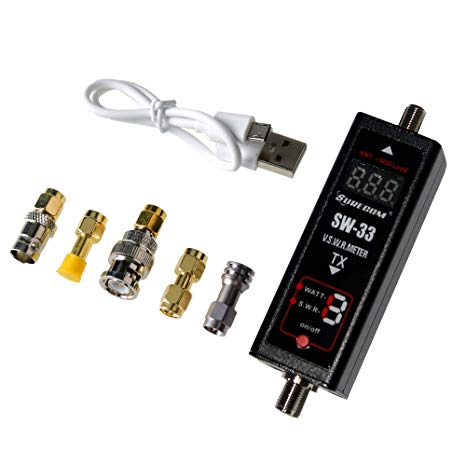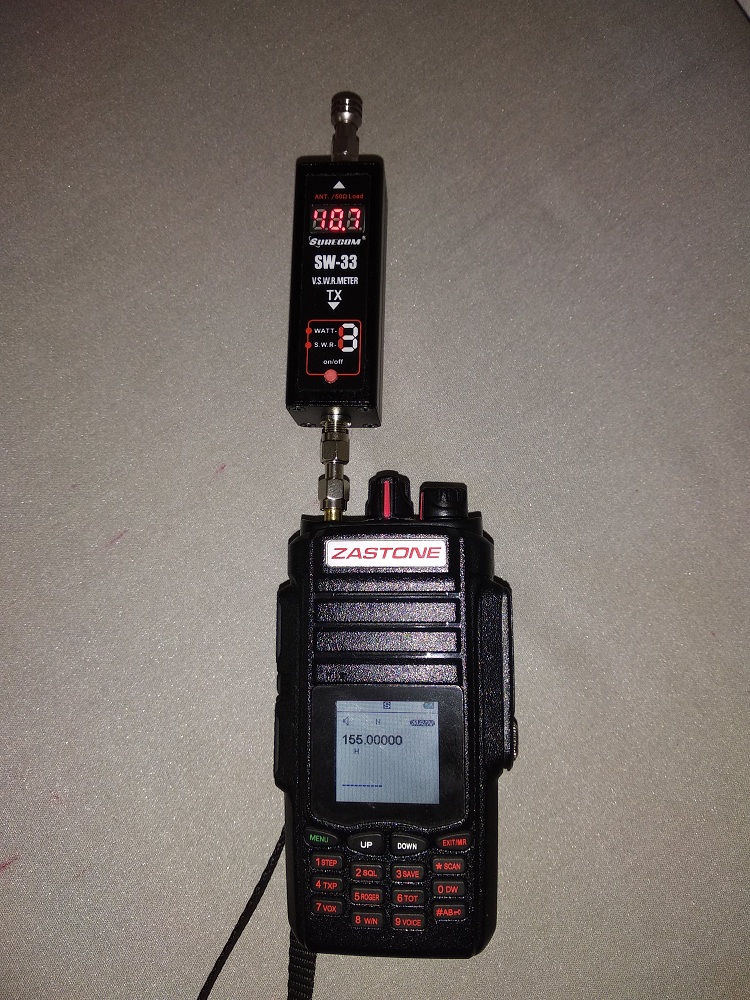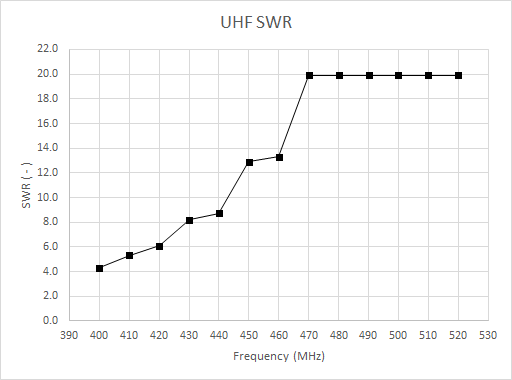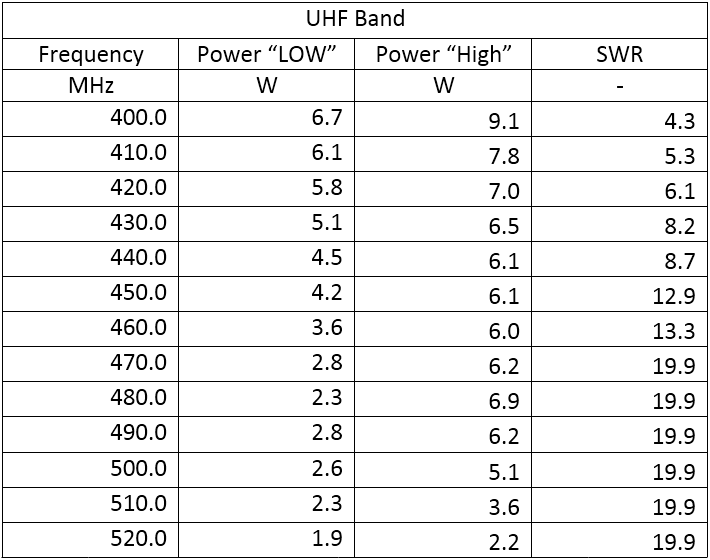Zastone ZT-A19 Radio Station: Performance Measurement
Recently, I purchased a portable radio Zastone ZT-A19. After studying various forums, reviews and reviews, it seemed to me that this radio station would be a good price-quality compromise. I made such a conclusion, relying to a greater extent on the reviews about the brand itself rather than about this particular model. And at that time, and now there are very few reviews on the Zastone ZT-A19 radio station on the Internet, and therefore I decided to personally measure the characteristics of the radio station and share them, as they say, with the population. I used an amateur device - a SWR meter SW-33, also ordered in one popular online store. In my experiment, I measured two characteristics: the output power of the radio station itself and the CWS of the standard antenna in the frequency range. The results of my research, see below.



Amateur SWR-meter SW-33 was used for measurements. Characteristics of the KSV-meter are given above. KSV-meter has two connectors: input and output. The input connector of the KSV-meter is connected to the antenna connector of the radio station. A 50-ohm SMA resistor can be connected to the output of the SWR meter to measure the output power, or an antenna for measuring the SWR of the antenna. The measurements were carried out for two power settings in the “HIGH” position and in the “LOW” position in two VHF and UHF frequency bands with a certain constant frequency step. Below are tables and graphs of measurements.

')

As we can see, in the VHF range, the radio station confidently delivers the claimed 10 watts at maximum power. However, in the UHF range, the output power drops sharply with increasing frequency and falls short of the stated 10 watts.


Both in the specification of the radio station and on the connector of the antenna itself, the operating frequency ranges are 400 - 480 MHz / 136 - 174 MHz. Nevertheless, from the graphs it can be seen that a good CWS at a regular antenna is only in the range of 140 - 145 MHz and is approximately equal to 1.50. In the bands 136 - 140 MHz, 145 - 160 MHz, 400 - 470 MHz, the SWR is, strictly speaking, bad. And in the ranges of 160 - 174 MHz and 470 - 480 MHz, the instrument hitch is observed, that is, the SWR is very bad.
Below are the measurement tables:


We found that the radio station does not reach the declared power. The quality of tuning the standard antenna for the declared frequency ranges leaves much to be desired. However, one should not think that this radiostation is bad. I think if you make similar measurements for any other radio station, for example Baofeng UV-5R, the results will be similar or even worse. But I did not conduct such tests.
It is clear that to provide output power in the entire frequency range is a difficult task from the point of view of radio electronics, as well as the task of tuning the antenna. And yet, I believe that the manufacturer is clearly not finalized. Personally, I just plan to buy a better antenna for this radio station, and the output power suits me perfectly. I also urge readers to conduct similar experiments with other popular radio stations and share the results in the comments.
A 50 ohm resistor is the ideal matched load for a radio station's output stage. At high frequencies, the radio waves propagate through the wires, obeying the wave equation, and therefore they can be partially reflected back from some sections of the circuit, for example, from some resistance in a line, or inductance. Antenna - the element is not ideal. It has its own frequency response with resonances by other effects, and therefore almost always the antenna partially reflects the power entering it back into the transmitter. This phenomenon is undesirable and even harmful, because firstly, the reflected power is released in the transmitter as heat, and secondly, it reduces the power radiated to the air. We want to imitate the situation when all the power is “radiated”. Therefore, instead of the antenna, you need to use a 50 Ohm resistor that simulates a perfectly matched (non-reflective) section of the circuit.
SWR, also known as SWR, is the standing-wave voltage coefficient, which just characterizes the number of reflections in the transmission line. When the line is not coordinated, a reflected (undesirable) wave arises in it along with the incident (useful) wave. As we know from physics, two waves going towards each other, form a standing wave. The standing wave ratio shows how large the reflected wave is compared to the incident wave. The smaller the CWS, the better. With a complete lack of reflection in the CWS line, it is equal to one. Values of the CWS in the range of 1 - 2 are considered good. If the CWS is very large, this means that the line is not consistent, and the radio wave experiences strong reflections.
Wave resistance is the ratio of the amplitudes of the electric and magnetic fields in the transmission line. When the electromagnetic wave propagates along the transmission line, the maxima of the electric and magnetic field strength alternate in the line. Since the electric field intensity is measured in V / m, and the magnetic field intensity in A / m, then if you divide one by the other, Ohms will be obtained. This value characterizes the effective resistance of the entire transmission line as a whole.
There are two matching standards in radio engineering: 50 and 75 Ohms. A 75 ohm standard is a coaxial cable with minimal losses, and a 50 ohm standard is a trade-off between minimum losses and maximum electrical strength that is achieved in a coaxial cable with a characteristic impedance of approximately 30 ohms. These values of wave resistance on which all radio engineering circuits are calculated. For example, when you connect a 50-ohm coaxial cable to a radio transmitter, the transmitter will “see” a 50-ohm resistor at its input, but only if the cable is infinitely long. In reality, this does not happen, and then something else is usually connected to the coaxial cable, for example, an antenna. An ideal antenna should have a wave impedance of 377 ohms, the same as the wave impedance of the vacuum, so between the antenna and the coaxial cable (feeder) often include a matching transformer, which reduces the antenna resistance from 377 to 50 ohms to the input of the transmitter. In this case, the radio waves “see” the same wave impedance at all parts of the circuit, and do not reflect back into the transmitter. In addition, the reception quality is also improving.
If there are still questions, please write in the comments - I will try to answer.
Radio station Zastone ZT-A19

Radio settings
- Brand: ZASTONE
- Model Number: ZT-A19
- 10 high power
- Frequency range: 400 - 480 MHz / 136 - 174 MHz
- Channel capacity: 999
- Antenna: Professional antenna
- Capacity of battery: 2800 mAh
- Operating voltage: DC 7.4 V
- Impedance of antenna: 50 Ω
- Dimensions: 125 x 56 x 31 mm
Measurement of the characteristics of the radio station and the standard antenna

Parameters of the SWR meter
- Model No. SW-33
- Max Power: 0.1 - 100 W
- VSWR: 1.00 - 19.9
- Frequency Range: 125 - 525 MHz
- Power in: 5 V (micro usb)
- Li-ion Battery: 3.7 V 500 mAh
- In / Out Impedance: 50 Ω
- Size without Socket: 25 x 25 x 60 mm
- Interface: SMA Female
- Net Weight: 160 g

Amateur SWR-meter SW-33 was used for measurements. Characteristics of the KSV-meter are given above. KSV-meter has two connectors: input and output. The input connector of the KSV-meter is connected to the antenna connector of the radio station. A 50-ohm SMA resistor can be connected to the output of the SWR meter to measure the output power, or an antenna for measuring the SWR of the antenna. The measurements were carried out for two power settings in the “HIGH” position and in the “LOW” position in two VHF and UHF frequency bands with a certain constant frequency step. Below are tables and graphs of measurements.
Output power measurement

')

As we can see, in the VHF range, the radio station confidently delivers the claimed 10 watts at maximum power. However, in the UHF range, the output power drops sharply with increasing frequency and falls short of the stated 10 watts.
Measurement of VSWR of a standard antenna


Both in the specification of the radio station and on the connector of the antenna itself, the operating frequency ranges are 400 - 480 MHz / 136 - 174 MHz. Nevertheless, from the graphs it can be seen that a good CWS at a regular antenna is only in the range of 140 - 145 MHz and is approximately equal to 1.50. In the bands 136 - 140 MHz, 145 - 160 MHz, 400 - 470 MHz, the SWR is, strictly speaking, bad. And in the ranges of 160 - 174 MHz and 470 - 480 MHz, the instrument hitch is observed, that is, the SWR is very bad.
Below are the measurement tables:


findings
We found that the radio station does not reach the declared power. The quality of tuning the standard antenna for the declared frequency ranges leaves much to be desired. However, one should not think that this radiostation is bad. I think if you make similar measurements for any other radio station, for example Baofeng UV-5R, the results will be similar or even worse. But I did not conduct such tests.
It is clear that to provide output power in the entire frequency range is a difficult task from the point of view of radio electronics, as well as the task of tuning the antenna. And yet, I believe that the manufacturer is clearly not finalized. Personally, I just plan to buy a better antenna for this radio station, and the output power suits me perfectly. I also urge readers to conduct similar experiments with other popular radio stations and share the results in the comments.
Explanations for those who are not familiar with radio engineering
Why do I need a 50 ohm terminal resistor instead of an antenna when measuring the output power?
A 50 ohm resistor is the ideal matched load for a radio station's output stage. At high frequencies, the radio waves propagate through the wires, obeying the wave equation, and therefore they can be partially reflected back from some sections of the circuit, for example, from some resistance in a line, or inductance. Antenna - the element is not ideal. It has its own frequency response with resonances by other effects, and therefore almost always the antenna partially reflects the power entering it back into the transmitter. This phenomenon is undesirable and even harmful, because firstly, the reflected power is released in the transmitter as heat, and secondly, it reduces the power radiated to the air. We want to imitate the situation when all the power is “radiated”. Therefore, instead of the antenna, you need to use a 50 Ohm resistor that simulates a perfectly matched (non-reflective) section of the circuit.
What is the CWS?
SWR, also known as SWR, is the standing-wave voltage coefficient, which just characterizes the number of reflections in the transmission line. When the line is not coordinated, a reflected (undesirable) wave arises in it along with the incident (useful) wave. As we know from physics, two waves going towards each other, form a standing wave. The standing wave ratio shows how large the reflected wave is compared to the incident wave. The smaller the CWS, the better. With a complete lack of reflection in the CWS line, it is equal to one. Values of the CWS in the range of 1 - 2 are considered good. If the CWS is very large, this means that the line is not consistent, and the radio wave experiences strong reflections.
What is wave resistance?
Wave resistance is the ratio of the amplitudes of the electric and magnetic fields in the transmission line. When the electromagnetic wave propagates along the transmission line, the maxima of the electric and magnetic field strength alternate in the line. Since the electric field intensity is measured in V / m, and the magnetic field intensity in A / m, then if you divide one by the other, Ohms will be obtained. This value characterizes the effective resistance of the entire transmission line as a whole.
What is a consistent line?
There are two matching standards in radio engineering: 50 and 75 Ohms. A 75 ohm standard is a coaxial cable with minimal losses, and a 50 ohm standard is a trade-off between minimum losses and maximum electrical strength that is achieved in a coaxial cable with a characteristic impedance of approximately 30 ohms. These values of wave resistance on which all radio engineering circuits are calculated. For example, when you connect a 50-ohm coaxial cable to a radio transmitter, the transmitter will “see” a 50-ohm resistor at its input, but only if the cable is infinitely long. In reality, this does not happen, and then something else is usually connected to the coaxial cable, for example, an antenna. An ideal antenna should have a wave impedance of 377 ohms, the same as the wave impedance of the vacuum, so between the antenna and the coaxial cable (feeder) often include a matching transformer, which reduces the antenna resistance from 377 to 50 ohms to the input of the transmitter. In this case, the radio waves “see” the same wave impedance at all parts of the circuit, and do not reflect back into the transmitter. In addition, the reception quality is also improving.
If there are still questions, please write in the comments - I will try to answer.
Source: https://habr.com/ru/post/450270/
All Articles